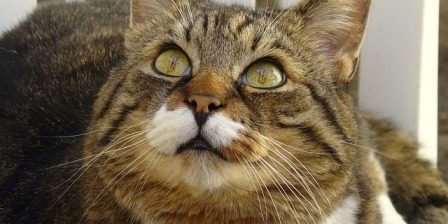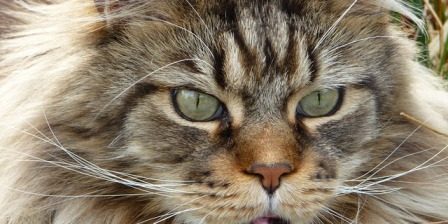Why cats prefer sleeping on their left side—and how it might help them survive
Cats overwhelmingly choose to sleep on their left side, a habit researchers say could be tied to survival. This sleep position activates the brain’s right hemisphere upon waking, perfect for detecting danger and reacting swiftly. Left-side snoozing may be more than a preference; it might be evolutio Read more
These frozen wolf cubs ate a woolly rhino—and changed what we know about dogs
Two Ice Age wolf pups once thought to be early dogs have been identified as wild wolves, thanks to detailed DNA and chemical analysis. Surprisingly, their last meals included woolly rhinoceros meat—an unusually large prey item—hinting that ancient wolves might have been bigger than today’s. Their we Read more
Telehealth can improve care for cats with chronic health issues
UC Davis researchers found that video telehealth visits help cat owners better care for arthritic cats without the stress of clinic visits. Owners appreciated personalized tips to improve their cat s comfort at home, and most said they'd pay for this convenient service. It s a game-changer for Read more
Genetic basis of purring in cats
Whether you are lucky enough to have a cat companion or must merely live this experience vicariously through cat videos, Felis catus is a familiar and comforting presence in our daily lives. Unlike most other feline species, cats exhibit sociality, can live in groups, and communicate both with other Read more
Genetic deep dive dispels fear of hybrid worm threat
Parasitic worms that infect humans are not interbreeding with those that infect cattle as previously thought. This is good news for when it comes to controlling schistosomiasis, a disease caused by these worms that affects more than 200 million people globally. Read more
When the forest is no longer a home -- forest bats seek refuge in settlements
Many bat species native to Germany, such as the Leisler's bat, are forest specialists. However, as it is becoming increasingly hard for them to find tree hollows in forest plantations, so they are moving to settlements instead. Using high-resolution GPS data from bats, a team led by scientists Read more
Managing surrogate species, providing a conservation umbrella for more species
A new study shows that monitoring and managing select bird species can provide benefits for other species within specific regions. Read more
Climate change poses severe threat to bowhead whale habitat
New research examining 11,700 years of bowhead whale persistence throughout the Arctic projects that sea ice loss due to climate change will cause their habitat to severely contract by up to 75 per cent. Read more
New research reveals Puff adders as an important conservation and rodent control solution
New research has revealed that puff adders (Bitis arietans) can be highly efficient at controlling rodent populations that threaten agricultural production on the continent. Read more
Novel molecular maneuver helps malaria parasite dodge the immune system
Researchers have discovered how a parasite that causes malaria when transmitted through a mosquito bite can hide from the body's immune system, sometimes for years. It turns out that the parasite, Plasmodium falciparum, can shut down a key set of genes, rendering itself 'immunologically in Read more
Wild orangutans show communication complexity thought to be uniquely human
Researchers have found that wild orangutans vocalize with a layered complexity previously thought to be unique to human communication, suggesting a much older evolutionary origin. Read more
Scientists track down mutation that makes orange cats orange
Many an orange cat-affiliated human will vouch for their cat's, let's say, specialness. But now scientists have confirmed that there is, in fact, something unique about ginger-hued domestic felines. In a new study, researchers have discovered the long-posited but elusive genetic mutation t Read more
Fewer parasites in the Indian River lagoon signal big ecosystem problems
Parasites are crucial indicators of ecosystem health, and their absence can signal trouble. Once pristine, Florida's Indian River Lagoon (IRL) now faces pollution and algal blooms that have damaged essential habitats like seagrass beds. New research finds parasite levels in the IRL are signific Read more
Halo patterns around coral reefs may signal resilience
A new study links grazing halo patterns in coral reefs, as well as those in other patchy habitats, to the spatial patterns of the shelter habitat itself. The researchers found that grazing halos are distinct when the coral is clustered but merge into each other when the coral is dispersed. Read more
Rhythmically trained sea lion returns for an encore -- and performs as well as humans
Animal research on biomusicality, which looks at whether different species are capable of behaving in ways that show they recognize aspects of music, including rhythm and beat, remains a tantalizing field at the intersection of biology and psychology. Now, the highly trained California sea lion who Read more
When sea stars fall, sea otters rise: Sea otters benefit from prey boom triggered by loss of ochre sea stars
In 2013, a sea star wasting syndrome decimated populations of Pisaster along the west coast of North America and along the Monterey Peninsula in California, where this study was conducted. The orange and purple stars have a hungry appetite for mussels in the rocky intertidal. Without the voracious s Read more
Giant croclike carnivore fossils found in the Caribbean
Imagine a crocodile built like a greyhound -- that's a sebecid. Standing tall, with some species reaching 20 feet in length, they dominated South American landscapes after the extinction of dinosaurs until about 11 million years ago. Or at least, that's what paleontologists thought. A new Read more









